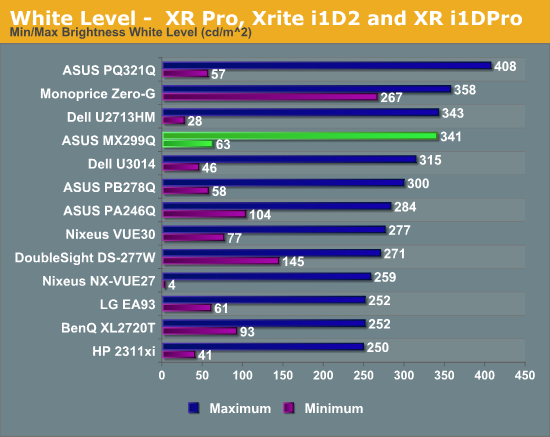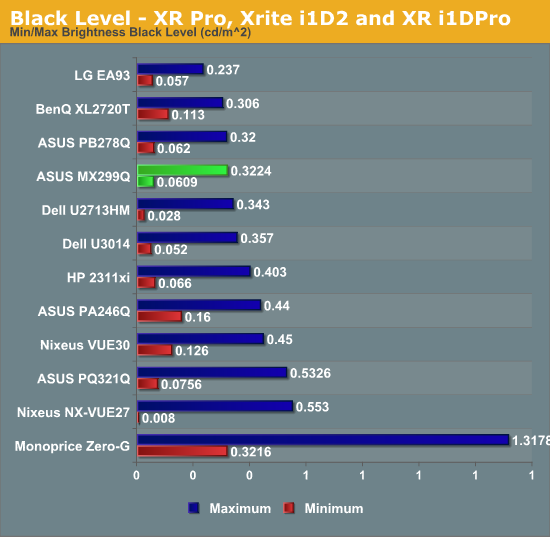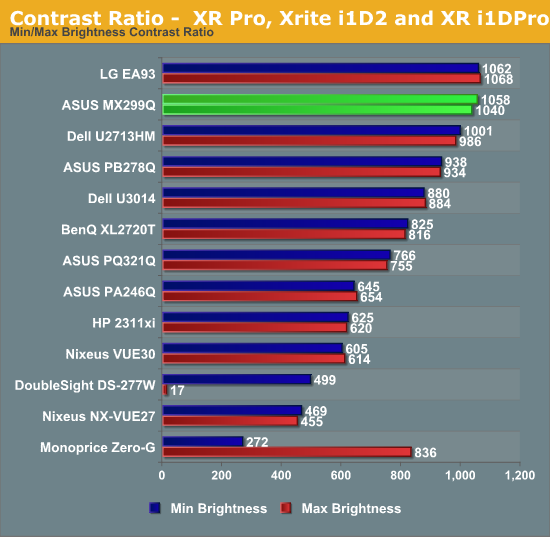ASUS MX299Q Monitor Review
by Chris Heinonen on September 23, 2013 12:00 AM ESTI usually pay little interest to the specs a manufacturer provides for contrast and brightness because they’re so easy to manipulate. Inflated contrast ratios on LED displays come from turning off the backlight and then measuring, as if we work on pure-black screens. Brightness is just as easy to mess with by pushing the panel too far. Everything is tinted and highlights are crushed, but you get a higher brightness reading that might sell. Really everyone is better off to ignore the ratings they see and instead consult with independent reviews.
ASUS manages to split the difference here by under-rating the brightness of the MX299Q but vastly overstating the contrast ratio. ASUS says the MX299Q can produce 300 cd/m^2 of brightness but I managed to produce 341 cd/m^2 from it in my testing. That should be plenty for anyone in regular use, even if you have lots of ambient light. Crank the brightness all the way down and you get 63 cd/m^2, providing you plenty of room in which to find a light level that is appropriate for your work environment.

The black level on the ASUS MX299Q is very good. Even with the backlight at maximum we see a black level of 0.3189 cd/m^2, placing it at the top of the pack. Turn the backlight to the minimum and the light output falls to a miniscule 0.0609 cd/m^2. Both of these are excellent numbers, especially for an IPS panel.

ASUS really got aggressive with their contrast rating of 80,000,000:1 on the MX299Q. The lowest black level any meter can reasonably measure is 0.0001, which would mean a peak white level of 8,000 cd/m^2. I don’t know exactly how bright that is, but I think you’ll be seeing spots or blinded if you looked at a monitor that bright. Needless to say, in practice the MX229Q (and other LCDs) get nowhere near such black levels.
The unfortunate thing is that ASUS has no reason to embellish here. Their actual contrast numbers of 1040:1 and 1058:1 are both excellent and rank among the best IPS displays that have been reviewed.

So ASUS might have been too conservative and too aggressive in their official specs for the MX299Q, but the real-world numbers are very good to see.










44 Comments
View All Comments
coolhardware - Monday, September 23, 2013 - link
For the past few years I have been using a Dell 30" 2560x1600 in landscape, sandwiched by two Dell 20" 1600x1200 displays in portrait mode.http://www.jdhodges.com/blog/shed-to-office-conver...
With the two side monitors rotated, all three monitors end up being the same height and pixel density... :-)
http://www.jdhodges.com/blog/ultimate-triple-monit...
(sorry the post is somewhat confusing, it was quickly put together when I was planning and initially installing... I really should update it!)
compcons - Monday, September 23, 2013 - link
I have a 27x9H which is a similar style to this one. There are NO VESA mounts and the stand mounts similar to most LCD TVs. One option is all that is available. Confirm that you can rotate it if necessary. Personally, I mounted my old gateway 22" on a monoprice desk mount and rotate it vertically when I need it.Nagorak - Tuesday, September 24, 2013 - link
Sounds to me like you're just going to end up with a crick in your neck.sjpxk992013 - Wednesday, October 2, 2013 - link
I have the Dell U2913 in portrait mode attached to a Thinkpad W520 with another Dell 24" as the landscape 1080p panel. With the laptop LCD running Metro in the center stack the two choices make working super easy.Road and Track for instance looks perfect in p-mode where my banking sites look better in standard l-mode
ComputerGuy2006 - Monday, September 23, 2013 - link
Although its nice not to be stuck in the old 1080p monitors, id like to see something with more sensible resolutions. Something between 1600p and 4k would be nice, or even 4k 60hz at decent prices....Kevin G - Monday, September 23, 2013 - link
3200 x 1800 resolution exists as it is found on some 15" notebooks. I wouldn't mind such a resolution on a 24" desktop display.There is also 3280 x 2048 resolution displays used for medical imaging but they're prohibitory expensive. 4K displays like the Asus PQ321Q are actually cheaper.
blanarahul - Monday, September 23, 2013 - link
Really, really awesome review. I especially loved the "Contrast Uniformity" chart. I hope others would do it too.althaz - Monday, September 23, 2013 - link
8,000 cd/m^2 is REALLY bright - it's about half a percent (0.5%) of the brightness of the sun. Half a percent might not seem like much, but we're talking about the sun, which is REALLY bright.DanNeely - Monday, September 23, 2013 - link
Assuming your comparison is using cd/m^2 for both and are measuring the sun as seen from the Earth; at any reasonable viewing distance that monitor would have a higher total luminosity than the sun.Geek tanning both anyone?
piroroadkill - Monday, September 23, 2013 - link
Wow, a monitor that wide is incredibly ugly.